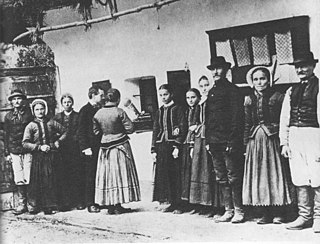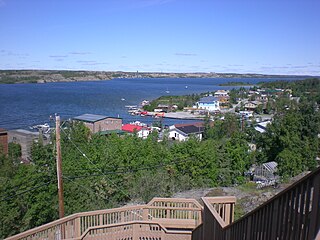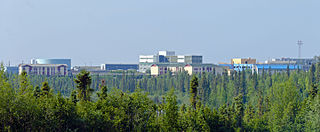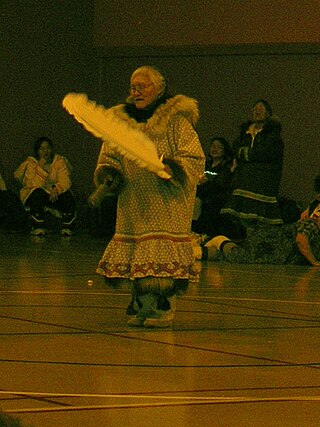
Folk music is a music genre that includes traditional folk music and the contemporary genre that evolved from the former during the 20th-century folk revival. Some types of folk music may be called world music. Traditional folk music has been defined in several ways: as music transmitted orally, music with unknown composers, music that is played on traditional instruments, music about cultural or national identity, music that changes between generations, music associated with a people's folklore, or music performed by custom over a long period of time. It has been contrasted with commercial and classical styles. The term originated in the 19th century, but folk music extends beyond that.

Stanley Allison Rogers was a Canadian folk musician and songwriter.
World music is an English phrase for styles of music from non-Western countries, including quasi-traditional, intercultural, and traditional music. World music's broad nature and elasticity as a musical category pose obstacles to a universal definition, but its ethic of interest in the culturally exotic is encapsulated in Roots magazine's description of the genre as "local music from out there".

Yukon is the smallest and westernmost of Canada's three territories. It is the third-least populated province or territory in Canada, with a population of 45,148 as of 2023. However, Whitehorse, the territorial capital, is the largest settlement in any of the three territories.

Yellowknife is the capital, largest community, and only city in the Northwest Territories, Canada. It is on the northern shore of Great Slave Lake, about 400 km (250 mi) south of the Arctic Circle, on the west side of Yellowknife Bay near the outlet of the Yellowknife River.
A roots revival is a trend which includes young performers popularizing the traditional musical styles of their ancestors. Often, roots revivals include an addition of newly composed songs with socially and politically aware lyrics, as well as a general modernization of the folk sound.

Susan Aglukark,, is a Canadian singer whose blend of Inuit folk music traditions with country and pop songwriting has made her a major recording star in Canada. Her most successful song/single is "O Siem", which reached No. 1 on the Canadian country and adult contemporary charts in 1995. Overall, she has released seven studio albums and has won three Juno Awards.

Inuvik is the only town in the Inuvik Region, and the third largest community in Canada's Northwest Territories. Located in what is sometimes called the Beaufort Delta Region, it serves as its administrative and service centre and is home to federal, territorial, and Indigenous government offices, along with the regional hospital and airport.

The music of Greenland is a mixture of two primary strands, Inuit and Danish, mixed with influences from the United States and United Kingdom.

Scotland is internationally known for its traditional music, which remained vibrant throughout the 20th century and into the 21st when many traditional forms worldwide lost popularity to pop music. Despite emigration and a well-developed connection to music imported from the rest of Europe and the United States, the music of Scotland has kept many of its traditional aspects and has influenced many other forms of music.
Indigenous music of Canada encompasses a wide variety of musical genres created by Aboriginal Canadians. Before European settlers came to what is now Canada, the region was occupied by many First Nations, including the West Coast Salish and Haida, the centrally located Iroquois, Blackfoot and Huron, the Dene to the North, and the Innu and Mi'kmaq in the East and the Cree in the North. Each of the indigenous communities had their own unique musical traditions. Chanting – singing is widely popular and most use a variety of musical instruments.

The Gwichʼin are an Athabaskan-speaking First Nations people of Canada and an Alaska Native people. They live in the northwestern part of North America, mostly north of the Arctic Circle.

Nunavut is a territory of Canada, inhabited predominantly by the Inuit and to a much smaller degree other members of the First Nations. Inuit folk music has long been based primarily off percussion, used in dance music, as well as vocals, including the famous Inuit throat singing tradition.
The state of Maine is located in the New England region of the northeastern United States. Its musical traditions extend back thousands of years to the music of the first peoples of Maine, the Penobscot Passamaquoddy, Wabanaki and other related Indigenous cultures.
The Vuntut Gwitchin First Nation (VGFN) is a First Nation in the northern Yukon in Canada. Its main population centre is Old Crow. The language originally spoken by the people is Gwichʼin.
Music of Canadian Cultures is a wide and diverse accumulation of music from many different individual communities all across Canada. With Canada being vast in size, the country throughout its history has had regional music scenes. The music of Canada has reflected the multi-cultural influences that have shaped the country. First Nations people, the French, the British, the United States and many others nationalities have all made unique contributions to the musical heritage of Canada
Over the course of centuries, many Indigenous Canadians have played a critical role in shaping the history of Canada. From art and music, to law and government, to sports and war; Indigenous customs and culture have had a strong influences on defining Canadian culture. The Indspire Awards are the annual awards presented by Indspire, formerly the National Aboriginal Achievement Foundation. The awards were first established in 1993 in conjunction with the United Nations declaring the 1990s "International Decade of the World's Indigenous peoples". June 21 is Canada's National Aboriginal Day, in recognition of the cultural contributions made by Canada's indigenous population. The day was first celebrated in 1996 following Governor General of Canada Roméo LeBlanc's proclamation.

Manitoban culture is a term that encompasses the artistic elements that are representative of Manitoba. Manitoba's culture has been influenced by both traditional and modern Canadian artistic values, as well as some aspects of the cultures of immigrant populations and its American neighbours. In Manitoba, the Minister of Culture, Heritage, Tourism and Sport is the cabinet minister responsible for promoting and, to some extent, financing Manitoba culture. The Manitoba Arts Council is the agency that has been established to provide the processes for arts funding. The Canadian federal government also plays a role by instituting programs and laws regarding culture nationwide. Most of Manitoba's cultural activities take place in its capital and largest city, Winnipeg.

Country music has a long history in Canada. The genre evolved out of the diverse musical practices of the Appalachian region of the United States. Appalachian folk music was largely Scottish and Irish, with an important influence also being the African American country blues. Parts of Ontario, British Columbia and the Maritime provinces shared a tradition with the Appalachian region, and country music became popular quite quickly in these places. Fiddlers like George Wade and Don Messer helped to popularize the style, beginning in the late 1920s. Wade was not signed until the 1930s, when Victor Records, inspired by the success of Wilf Carter the year before, signed him, Hank Snow and Hank LaRivière.
Athabaskan fiddle is the old-time fiddle style that the Alaskan Athabaskans of the Interior Alaska have developed to play the fiddle (violin), solo and in folk ensembles. Fiddles were introduced in this area by Scottish, Irish, French Canadian, and Métis fur traders of the Hudson's Bay Company in the mid-19th century. Athabaskan fiddling is a variant of fiddling of the American southlands. Athabaskan fiddle music is most popular genre in Alaska and northwest Canada and featuring Gwich'in Bill Stevens and Trimble Gilbert.











